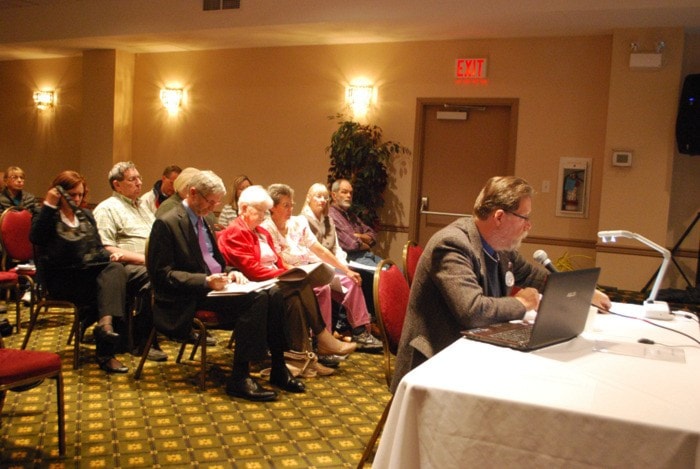Residents and area politicians voiced their opposition to proposed federal electoral boundary changes at Tuesday night’s hearing at the Best Western in Nelson.
The new Kootenay-Columbia riding would include Nelson, Harrop, Procter, Salmo, and Nakusp, while Castlegar, Trail, Fruitvale, Kaslo, New Denver, Silverton, and Slocan join South Okanagan-West Kootenay.
While many locals shared their thoughts on the potential shift, politicians agreed the new riding boundaries would have a negative effect have on the area’s communities.
Regional District of Central Kootenay Area D director Andy Shadrack began the presentations by stating the historical, economic and social ties Nelson has to Trail and Castlegar and also Nakusp’s connection to the tri-cities instead of Revelstoke and Vernon.
Shadrack proposed amendments to the potential ridings suggesting regional district areas D, H and K, and Nakusp be part of the new South Okanagan-West Kootenay riding.
He also suggested the portion of Electoral Area B in Columbia-Shuswap Regional District just north of Beaton Arm and to the east to the height of land bordering the RDCK’s Area D including Trout Lake be canvassed to determine which riding they would prefer.
“Nelson is this region’s centre and it should remain that way,” said Shadrack.
Many of the evening’s presenters, including Shadrack, expressed concerns around the inclusion of Penticton in the former BC Southern Interior riding.
“Penticton will dominate the riding,” said Shadrack. “It will lose the rural character of the riding.”
Nelson-Creston MLA Michelle Mungall agreed with Shadrack’s suggestions and said the proposed boundary shift fails to recognize the region’s need for fair and effective representation to the Government of Canada.
“Knowing what travel is like for Nelson-Creston alone, I can expertly say the geographic realities of a riding with a population above the electoral quotient that includes Nelson, Golden, Nakusp, Cranbrook, Elkford and dozens of small unincorporated communities, or a riding that includes Kaslo, Slocan, Castlegar and Penticton and multiple mountain ranges and passes, simply would not be manageable,” Mungall told the commission.
Mungall commented on how, unlike her colleague Vancouver -West End MLA Spencer Herbert who can walk around his riding in an hour, communities in the Southern Interior and Kootenay-Columbia riding are smaller and spread out.
“I say with 100 per cent confidence the boundaries as proposed put Kootenay residents at a disadvantage and reduce their access to their representative,” said Mungall.
Current representative for the area, BC Southern Interior MP Alex Atamanenko, said he finds the current riding manageable and believes with the changes suggested by Shadrack it would continue to be manageable.
“The tri-cities have worked together on various sporting events including the BC Seniors Games, the share Selkirk College and work together on various partnerships,” he said.
Atamanenko expressed concerns about issues in rural communities being engulfed by the larger communities like Penticton if it were to be included in the riding.
“It seems to be a consensus that the current riding may not be perfect, but it works,” he said. “While there are many things to consider when making this decision, geography for the ridings should be the main criteria.”
When Nelson Mayor John Dooley addressed the commission he said even though the provincial electoral riding and the Regional District of Central Kootenay includes Creston, “three wrongs don’t make a right?”
“Looking at the map it makes no sense,” said Dooley. “There is strength in our regional economies and despite differences in our populations, there are also many similarities.”
Dooley also commented on the co-operation between Nelson, Trail and Castlegar around arts and sports events, hospital services and more.
“I know you have a difficult decision ahead,” he told the commission. “But common sense needs to prevail.”
Opposition to the proposed changes also came from Village of Slocan Mayor Madeleine Perriere who would see her municipality move to the South Okanagan-West Kootenay riding.
“The existing boundaries serve our residents well,” said Perrier. “Changes to the ridings would be harmful to established patterns of local government.”
Perrier emphasized the historic connection Slocan has to Nelson, Castlegar and Trail and the way the communities work together in promoting activities for the region.
“The proposed changes do not comply with the goal of good representation for all citizens,” she said.
Residents of Balfour, Harrop, Proctor and the North Shore voiced concerns about how the boundary shift would impact their communities.
According to the map provided by the commission Harrop and Proctor would be in the Kootenay-Columbia riding while Balfour would be in the South Okanagan-West Kootenay.
“Kootenay Lake is a natural feature for our area and the tie that binds us,” said Regional District of Central Kootenay director Area E Ramona Faust, who represents Balfour, Harrop and Proctor. “Harrop and Proctor are joined to Nelson. They go to Nelson for shopping, and many of the communities that would be severed share schools and hospitals.”
The commission will continue to travel around the province and the region hearing other presentations.
